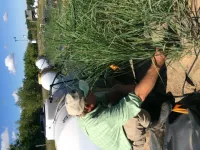INFORMATION:
Researchers said that because of the scale of explosives pollution, particularly on military training ranges, there is considerable interest in developing plant-based sustainable remediation strategies. This research was funded by the Environmental Security Technology Certification Program (ESTCP) of the US Department of Defense and was in collaboration with researchers at the Engineering Research and Development Centre, U.S. Army Corps of Engineers and the University of Washington.
The paper, 'Field trial demonstrating phytoremediation of the military explosive RDX by XplA/XplB-expressing switchgrass' is published in Nature Biotechnology. END
GM grass cleanses soil of toxic pollutants left by military explosives, new study shows
Genetically modified grass cleanses soil of toxic pollutants left by military explosives, new research shows
2021-05-03
(Press-News.org) A grass commonly used to fight soil erosion has been genetically modified to successfully remove toxic chemicals left in the ground from munitions that are dangerous to human health, new research shows.
The study - led by the University of York- demonstrates that genetically modified switchgrass (Panicum virgatum) can detoxify residues of the military explosive, RDX, left behind on live-fire training ranges, munitions dumps and minefields.
RDX has been a major component of munitions since WW2 which are still used extensively on military training grounds. This use has now resulted in widespread pollution of groundwater.
Researchers generated the plants by inserting two genes from bacteria able to breakdown RDX. The plants were then grown in RDX contaminated soil on a US military site. The genetically modified grass grew well and successfully degraded RDX to non-detectable levels in their plant tissues.
Study authors, Professor Neil Bruce from the Department of Biology and Director of the Centre for Novel Agricultural Products (CNAP) and Dr Liz Rylott, also from CNAP believe it is the first successful example of the use of a GM plant in-the-field to remove organic pollutants, which are resistant to environmental degradation.
Dr Rylott said: "The removal of the toxic RDX from training ranges is logistically challenging and there is currently a lack of cost-effective and sustainable solutions.
"Our research demonstrates how the expression, in switchgrass, of two bacterial genes that have evolved specifically to degrade RDX give the plants the ability to remove and metabolise RDX in the field at concentrations relevant to live fire military ranges.
"We demonstrated that by inserting these genes into switchgrass, the plant then had the ability to degrade RDX to non-detectable levels in the plant tissue."
The study confirmed that the plants were able remove and degrade RDX at a rate of 27 kg RDX per hectare. RDX is designated as a priority pollutant by the US Environmental Protection Agency and is of significant and increasing public concern. In the US, over 10 million hectares of military land are contaminated with munitions components, of which, RDX is a major component.
Professor Bruce added: "The recalcitrance of RDX to degradation in the environment, combined with its high mobility through soil and groundwater, mean that plumes of toxic RDX continue to spread below these military sites, threatening drinking water supplies."
The paper sites an example when in 1997, plumes of RDX pollution were discovered in both groundwater and the aquifer beneath the training range at the Massachusetts Military Reservation in Cape Cod. The aquifer is the sole source of drinking water for half a million people and resulted in the Environment Protection Agency preventing use of all live munitions during training at this site.
The study says that the continuing demand for vast amounts of military explosives means that RDX will continue to be manufactured and used globally on a massive scale for the foreseeable future.
ELSE PRESS RELEASES FROM THIS DATE:
Researchers wirelessly record human brain activity during normal life activities
2021-05-03
Researchers are now able to wirelessly record the directly measured brain activity of patients living with Parkinson's disease and to then use that information to adjust the stimulation delivered by an implanted device. Direct recording of deep and surface brain activity offers a unique look into the underlying causes of many brain disorders; however, technological challenges up to this point have limited direct human brain recordings to relatively short periods of time in controlled clinical settings.
This project, published in the journal Nature Biotechnology, was funded by the National Institutes of Health's ...
CityU scientists invent cryomicroneedles for intradermal therapeutic cell delivery
2021-05-03
A research team led by City University of Hong Kong (CityU) scientists recently developed a new generation of microneedles technology which allows the intradermal delivery of living cells in a minimally invasive manner. Their experiment showed that vaccination using therapeutic cells through this ground-breaking technology elicited robust immune responses against tumours in mice, paving the way for developing an easy-to-use cell therapy and other therapeutics against cancers and other diseases.
The study was led by Dr Xu Chenjie, Associate Professor at the Department of Biomedical Engineering (BME) at CityU. The latest findings have been published in the scientific journal Nature Biomedical Engineering, titled "Cryomicroneedles for Transdermal Cell Delivery".
The new technology ...
Scientists find small molecule cocktail to improve stem cell use in research, medicine
2021-05-03
Researchers at the National Institutes of Health (NIH) have devised a four-part small-molecule cocktail that can protect stem cells called induced pluripotent stem cells (iPSCs) from stress and maintain normal stem cell structure and function. The researchers suggest that the cocktail could enhance the potential therapeutic uses of stem cells, ranging from treating diseases and conditions -- such as diabetes, Parkinson's disease and spinal cord injury -- to genome editing.
Human pluripotent stem cells are cells that, in theory, can grow forever and serve as an inexhaustible source for specialized cells, such as brain, kidney and heart cells. But stem cells are sensitive, and their potential uses in ...
Mini 3D brain models could speed up search for MS treatments
2021-05-03
Tiny 3-D models that mimic vital aspects of the human nervous system have been developed in a step that could accelerate drug research for neurological conditions such as multiple sclerosis (MS).
The millimetre-wide models - created using stem cells from human skin samples - will be used to study myelin, an insulating substance that helps nerve cells communicate with each other.
Researchers say the models are the most natural representation of human myelination developed in a lab and are a promising platform for studying neurological diseases and for testing drugs for conditions linked to myelin loss, including MS.
Nerve cells are found in the brain and the spinal cord and connect to each other with ...
COVID-19 conspiracy beliefs increased among users of conservative and social media
2021-05-03
PHILADELPHIA - Belief in conspiracies about the COVID-19 pandemic increased through the early months of the U.S. outbreak among people who reported being heavy users of conservative and social media, a study by Annenberg Public Policy Center (APPC) researchers has found. ...
Stress and mental health problems during first COVID-19-lockdown
2021-05-03
Many people in Switzerland experienced considerable psychological distress during the first COVID-19 lockdown from mid-March to the end of April 2020. Researchers from the Department of Child and Adolescent Psychiatry and Psychotherapy at the University Hospital of Psychiatry Zurich (PUK) and the University of Zurich in collaboration with the La Source School of Nursing have now examined the most common sources of stress among children, adolescents, their parents and young adults. For their study, the researchers used representative samples in Switzerland of 1,627 young adults aged 19 to 24 as well as 1,146 children and adolescents between the ages of 12 and 17 and their parents.
Uncertainty, disruption, postponement
"Uncertainty during last year's lockdown was considerable ...
Flatfish got weird fast due to evolutionary cascade
2021-05-03
HOUSTON - (May 3, 2021) - Ever look at a flatfish like a flounder or sole, with two eyes on one side of its head, and think, "How did that happen?"
You're in luck. Rice University biologist Kory Evans has the answer.
"Flatfishes are some of the weirdest vertebrates on the planet, and they got weird very, very fast by changing multiple traits at once over a short period of time," said Evans, an assistant professor of biosciences at Rice who specializes in studying the evolution of fish over long time scales.
Of all mammals, reptiles, birds, amphibians and fish, flatfish are easily the most asymmetric. Evans, the corresponding author ...
Equipping crop plants for climate change
2021-05-03
Biologists at Ludwig-Maximilians-Universitaet (LMU in Munich) have significantly enhanced the tolerance of blue-green algae to high light levels - with the aid of artificial evolution in the laboratory.
Sunlight, air and water are all that cyanobacteria (more commonly known as blue-green algae), true algae and plants need for the production of organic (i.e. carbon-based) compounds and molecular oxygen by means of photosynthesis. Photosynthesis is the major source of building blocks for organisms on Earth. However, too much sunlight reduces the efficiency of photosynthesis because it damages the 'solar panels', i.e. the photosynthetic machineries of cyanobacteria, algae and plants. A team of researchers led by LMU biologist Dario Leister has ...
Genetics, not the intrauterine environment, controls abnormal development
2021-05-03
New Haven, Conn. --Yale researchers have shown that developmental abnormalities, including those that lead to pregnancy loss and autism, are controlled by the genetics of the fetus and placenta -- and not the mother's intrauterine environment.
The findings are reported in the April 28 online edition of the journal Placenta.
One out of every 33 children is diagnosed with a birth defect each year in the United States, according to the Centers for Disease Control and Prevention (CDC). This translates into one baby born every 4 ½ minutes -- or 120,000 per year.
"Mothers ...
Newly identified saber-toothed cat is one of largest in history
2021-05-03
COLUMBUS, Ohio - A giant saber-toothed cat lived in North America between 5 million and 9 million years ago, weighing up to 900 pounds and hunting prey that likely weighed 1,000 to 2,000 pounds, scientists reported today in a new study.
The researchers completed a painstaking comparison of seven uncategorized fossil specimens with previously identified fossils and bone samples from around the world to describe the new species. Their finding makes a case for the use of the elbow portion of the humerus - in addition to teeth - to identify fossils of large saber-toothed cats whose massive forearms enabled ...
LAST 30 PRESS RELEASES:
Tracing the quick synthesis of an industrially important catalyst
New software sheds light on cancer’s hidden genetic networks
UT Health San Antonio awarded $3 million in CPRIT grants to bolster cancer research and prevention efforts in South Texas
Third symposium spotlights global challenge of new contaminants in China’s fight against pollution
From straw to soil harmony: International team reveals how biochar supercharges carbon-smart farming
Myeloma: How AI is redrawing the map of cancer care
Manhattan E. Charurat, Ph.D., MHS invested as the Homer and Martha Gudelsky Distinguished Professor in Medicine at the University of Maryland School of Medicine
Insilico Medicine’s Pharma.AI Q4 Winter Launch Recap: Revolutionizing drug discovery with cutting-edge AI innovations, accelerating the path to pharmaceutical superintelligence
Nanoplastics have diet-dependent impacts on digestive system health
Brain neuron death occurs throughout life and increases with age, a natural human protein drug may halt neuron death in Alzheimer’s disease
SPIE and CLP announce the recipients of the 2025 Advanced Photonics Young Innovator Award
Lessons from the Caldor Fire’s Christmas Valley ‘Miracle’
Ant societies rose by trading individual protection for collective power
Research reveals how ancient viral DNA shapes early embryonic development
A molecular gatekeeper that controls protein synthesis
New ‘cloaking device’ concept to shield sensitive tech from magnetic fields
Researchers show impact of mountain building and climate change on alpine biodiversity
Study models the transition from Neanderthals to modern humans in Europe
University of Phoenix College of Doctoral Studies releases white paper on AI-driven skilling to reduce burnout and restore worker autonomy
AIs fail at the game of visual “telephone”
The levers for a sustainable food system
Potential changes in US homelessness by ending federal support for housing first programs
Vulnerability of large language models to prompt injection when providing medical advice
Researchers develop new system for high-energy-density, long-life, multi-electron transfer bromine-based flow batteries
Ending federal support for housing first programs could increase U.S. homelessness by 5% in one year, new JAMA study finds
New research uncovers molecular ‘safety switch’ shielding cancers from immune attack
Bacteria resisting viral infection can still sink carbon to ocean floor
Younger biological age may increase depression risk in older women during COVID-19
Bharat Innovates 2026 National Basecamp Showcases India’s Most Promising Deep-Tech Ventures
Here’s what determines whether your income level rises or falls
[Press-News.org] GM grass cleanses soil of toxic pollutants left by military explosives, new study showsGenetically modified grass cleanses soil of toxic pollutants left by military explosives, new research shows



